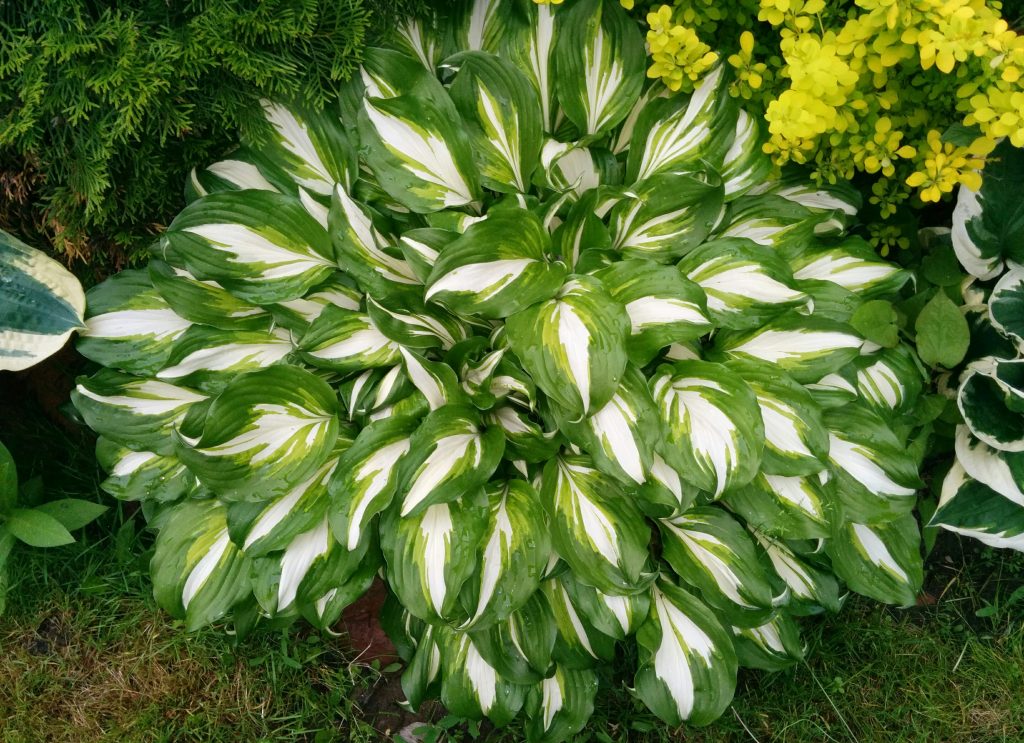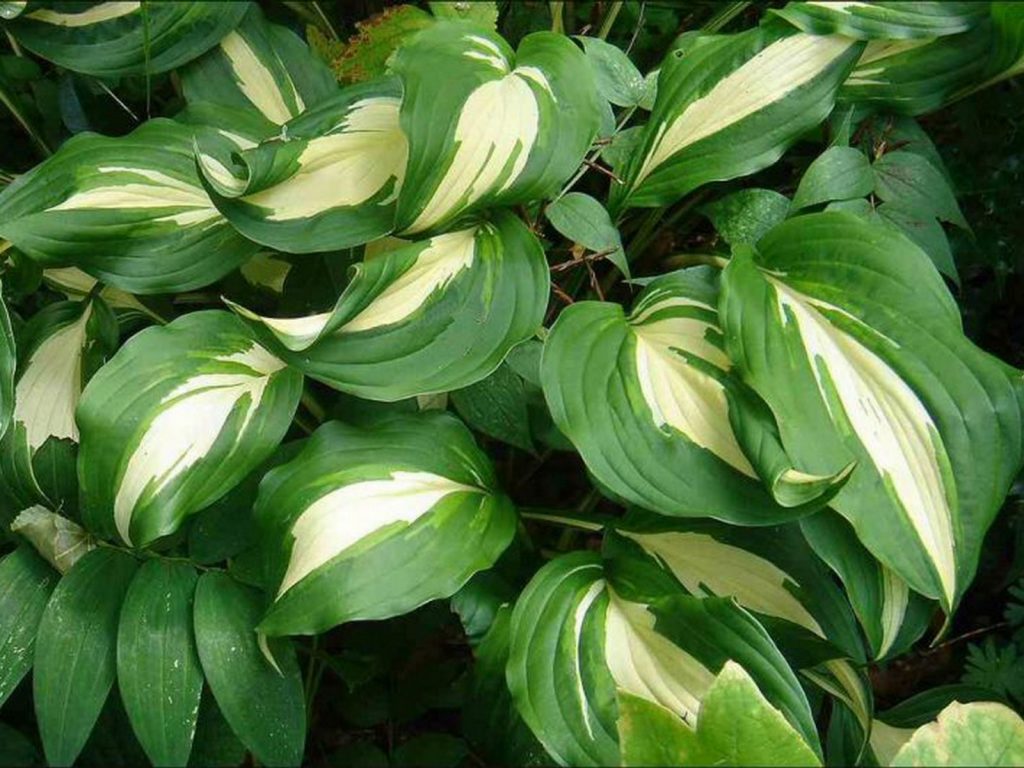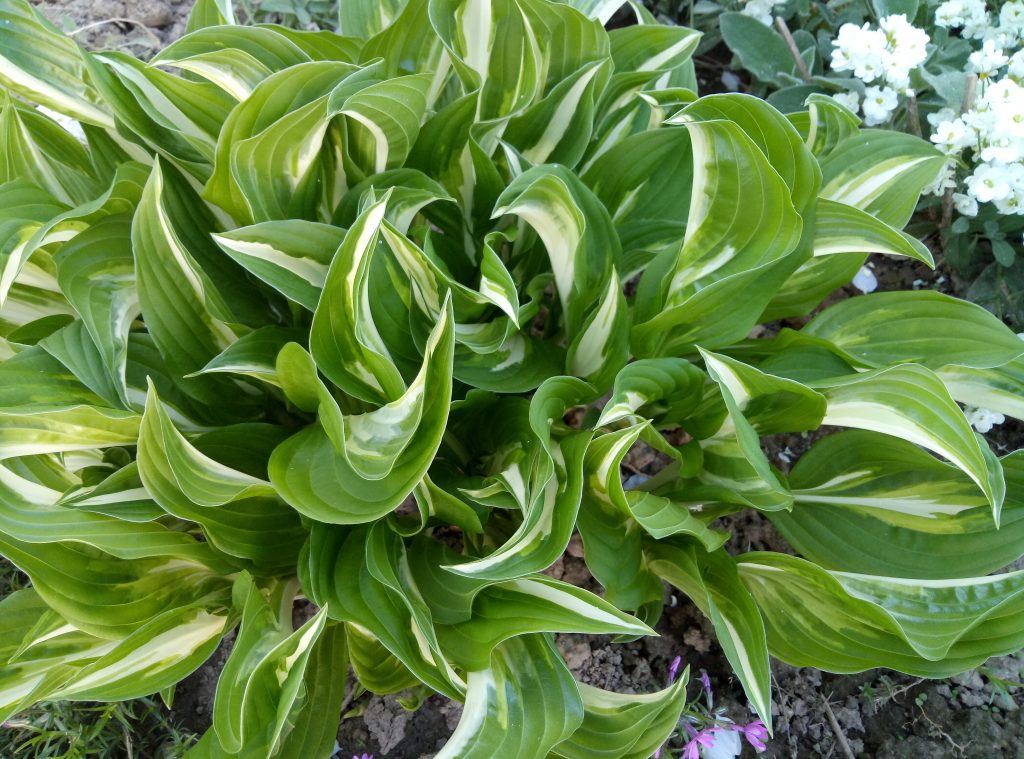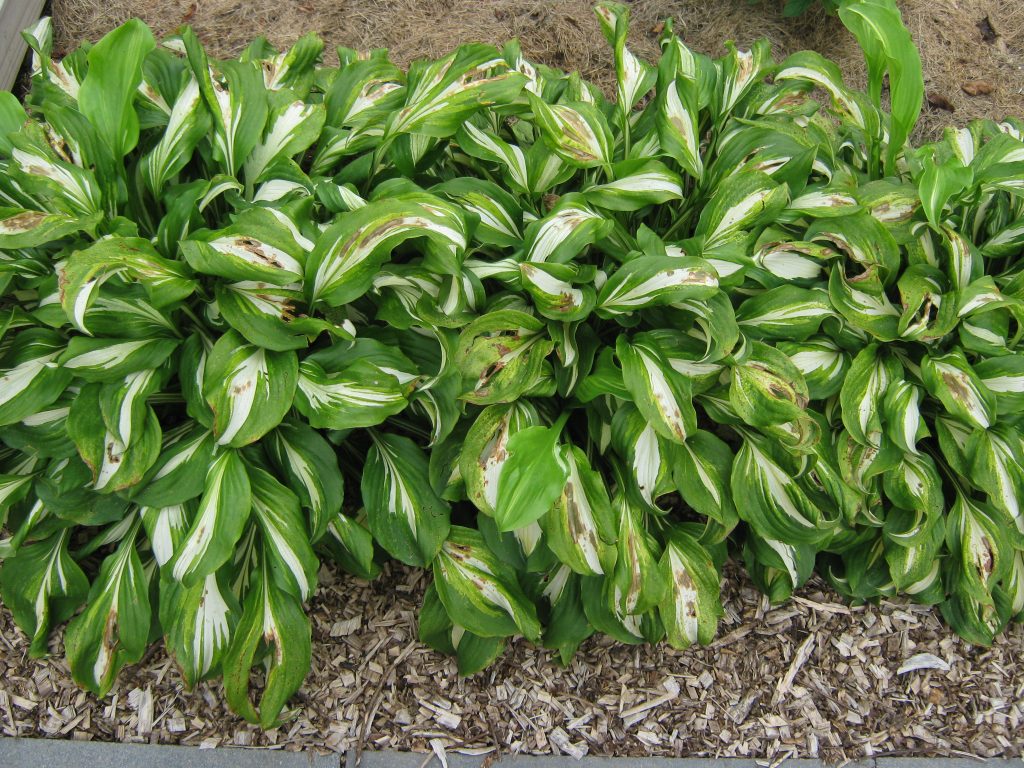Wavy hosta Mediovariegata - an extraordinary variety
Hosta Mediovariegata (Undulata Mediovariegata) is a popular decorative perennial from the Asparagus family. It has been known for a long time - since 1930 (the originator of the variety is F. Maekawa). The name is translated as "wavy" function with "variegated middle", which very well illustrates the features of variegated leaves.

Host media variety description
Description of the variety
Undulata Mediovariegata belongs to the medium-sized host group. It reaches a height of 50 cm, in diameter it grows to 60-70 cm. The bush is hemispherical with densely growing leaves (15-20 cm long, 10-12 cm wide).
Heart-shaped leaves have wavy edges and bright variegation - a creamy white cent and a feathery green border.
Hosta bloom begins in late June-mid-July and lasts about a month. On tall leafless peduncles (up to 80 cm), inflorescences of purple-lilac bells appear. They do not have a pronounced aroma.
Landing features
Like all variegated hosts, Mediovariegata wavy prefers light partial shade or diffused sunlight to complete shade. It grows well in the shade, but the leaves are not so bright, variegated and contrasting. The function loves fertile soils, loams with a neutral or slightly acidic reaction.
The plant should not be planted in places where melt and rain moisture accumulates, as well as in places where groundwater is located close to the surface. If there is no choice, it is necessary to make an embankment before planting and provide the hole with a thick layer of drainage.
The distance from the seedling to the nearest perennials should be at least 45-50 cm.
Technology:
- In the dug and loosened area, a hole is dug with a diameter and depth of 50-60 cm.
- The bottom is covered with a drainage layer (gravel, pebbles, broken brick).
- Garden soil is mixed with rotted manure, compost, peat, mineral fertilizers.
- The hole is covered by a third with a substrate, poured with a bucket of water and wait until the moisture is absorbed.
- Place the plant with the lump.
- The remaining soil mixture is poured, tamped, watered again, mulched with pine needles or bark.
Care
The function of undulata Mediovariyegat is an unpretentious plant that is quite easy to care for. All she needs is regular but moderate watering, annual pruning and a few dressings per season.
If the hosta grows in fertile soil, no fertilization can be applied at all.
Watering
Water the funkia 2-3 times a week, depending on the condition of the soil. The soil should be moderately moist, but free from dirt or stagnant water. Watering is carried out in the morning, directing the stream under the root, and not over the leaves.

Host media variety photo
Top dressing
Spring and autumn feeding is combined with mulching. The soil around the bush is covered with peat or compost, creating a supply of nutrients, reducing evaporation, protecting the roots from overheating and facilitating maintenance.
At the beginning of the flowering period, you can additionally feed the funky with complex mineral fertilizers.
Pruning and preparing for winter
After flowering, dry peduncles are pruned, and with the onset of autumn cold - yellowed leaves. Some gardeners choose to prune their shrubs in the spring rather than in the fall. For the winter, you can cover adult hosts with dry foliage, and young seedlings with spruce branches.
Reproduction
Hosta Undulata Mediovariegata reproduces by cuttings and dividing the bush. Sowing seeds, unfortunately, does not allow to obtain plants with pronounced varietal characteristics. Cuttings are recommended to be rooted in the spring, but some gardeners carry out this procedure repeatedly during the summer.
Cuttings
A leaf rosette with a heel is cut off and treated with Kornevin. Garden soil in partial shade is dug up, loosened, mixed with peat and well moistened. Cuttings are deepened into the soil and covered with cut plastic bottles. Rooting occurs within 3-5 weeks.

Hosta undulata mediovariegata
Dividing the bush
It is not recommended to divide the bushes too often, since the function does not have time to grow. It is optimal to carry out the procedure every 5-6 years. The bushes are dug up and divided into equal parts (each must have a bud). Delenki are planted in partial shade and watered regularly.
Diseases and pests
| Problem | Symptoms | Prophylaxis | Wrestling |
| Slugs | In young leaves, pests eat holes that remain on the host all summer and spoil the decorative look. | Water the plants correctly, without getting water on the leaves. Sprinkle the soil with ash, soda, salt, tobacco. | Use special drugs: Bros, Thunderstorm, Slime-eater, Ferromol. |
| Rot | The leaves turn brown and curl starting at the tips. The plant becomes sticky, softens, withers, stops growing. | Spray the place for planting with medicinal preparations. Avoid waterlogging and stagnation of water, disinfect garden tools. | Dig up the bush and check the roots for decay. Cut off the affected parts, sprinkle the cuts with crushed coal. Treat the plant with a fungicide, transplant it into healthy soil in a new place. |
Use in landscape design
Hosta undulata Mediovariegata is widely used in landscape design. It fits well into natural style gardens, rock gardens, rockeries, flower gardens. A lush bush fills the space under trees and perennials with leafless stems. It looks great as a tapeworm, can serve as a living border and complement group compositions.

Hosta mediovariegata
The function is suitable for container growing, which allows landscaping of yards without planting land. It goes well with conifers, cereals, monochromatic green shrubs. In the flower garden, a rose, delphinium, astilbe, daylily, and peony will become a good neighbor for her.
Testimonials
The media variety is very popular among gardeners due to its easy care, endurance, unpretentiousness and excellent decorative effect. Judging by the descriptions, she almost does not get sick, is rarely affected by pests, with the exception of slugs. However, growers note that this function is sensitive to sunburn and does not grow well in the sun.
In partial shade, the bush grows quickly and pleases with beautiful, lush, bright leaves. It is noticed that the border on the leaves can be more or less wide, depending on the variety of the variety and growing conditions. Often as many as three colors are originally combined on the leaves: creamy white in the center, which turns into light green "feathers", and then into a dark green border.

